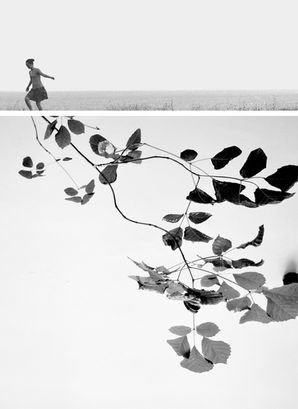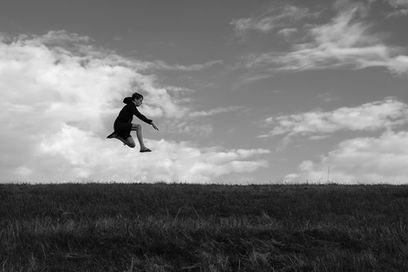
NOTES ON A LANDSCAPE
June 24, 2022
INTERVIEW
PHOTOGRAPHY Mostafa Nodeh
INTERVIEW Melanie Meggs
Very poetic and existential in nature, Mostafa Nodeh’s photography invites us to reflect on the deeper questions in life. What is the meaning of it? How are we spending it? Or to engage with more politically charged questions such as which lives matter? Or who is disposable?
Mostafa is an Iranian artist and self-taught photographer based in Guilan, on the northern coast of Iran. He is known for his captivating symbolic minimalist landscape photographs in black and white. The barren landscapes, footsteps in the snow, birds flying towards freedom, tiny people against large constructions, ladders, and winding roads can be interpreted as metaphors of life. They all hint of a journey, a long slow walk and the paths there are to choose within it.
Mostafa’s world could in many ways be described as a world of contrasts. At first we are struck by the beauty and simplicity of Mostafa's work, however, beneath this facade hides deeper meaningful philosophies. The dark shadows, strong lines and sharp geometric shapes create a striking presence, as Mostafa describes, “like an emerging storm they hint of unease, which is further empathized by the distance to the subjects that appear small against large landscapes, constructions and the overall brutal and raw force of nature.” At the same time, the light, warm tones and soft organic textures emit a strong sense of serenity, peace and hope, “a calm after a storm and the promise of a bright future.”
With a background in painting and while photography is his preferred medium today, Mostafa recognises a strong link between painting and photography, often combining aspects of both into his working process, and is visible in the photographs themselves. Mostafa's minimalist works are a combination of preconceived ideas, often inspired by his own thoughts and dreams, and chance and coincidence, twisting the notion of time and space, making it impossible for us to anchor in any reality to us. His masterful transitions between light and shadow, the texture, tone, shading and color, which at times resemble aspects of painting, but also in his dreamlike treatment of the subject matter and in the overall composition.

“To me, minimal photography is an art in the way that artists learn how to omit the extra elements which seem to be very necessary in such a hectic life. I see it as an international language to communicate with the people round the world.”
IN CONVERSATION WITH MOSTAFA NODEH
THE PICTORIAL LIST: Mostafa please tell us about yourself.
MOSTAFA NODEH: I was born in one of the farthest northern regions in a village called Nodeh. Nodeh village is one of the regions of Gilan. Unfortunately, due to working conditions and earning income, I migrated from this beautiful village and settled in a city called Zibashahr, Qazvin. I worked as a photographer due to the difficult economic conditions in Iran. In my country, artists face many problems, and I am no exception to this rule.
TPL: You have a background in painting. What was that moment that you decided to put down the paintbrush and pick up a camera? How does your use of the camera as a tool influence your use of it in recent years as a means for self-expression and emotion?
MN: Yes, I loved to draw with a pencil and I used to put the images that came to my mind on paper. My paintings were great at school and sometimes I painted for my classmates. I loved magazines and dailys that had photos, and I would cut those photos with scissors and turned them into an album as I wished. I would then stick them to my office wall. This interest led me to get a small compact camera and eventually a professional Canon 7d camera with a lens of 18-135mm.
TPL: Very poetic and existential in nature, your works invite us to reflect on the deeper questions in life. What is the story you want your photographs to tell?
MN: Yes, it is. In each of my works, there is a story where the audience starts to tell a story.
One day, a writer by the name, Azin Jahanian, saw my photos and started writing for dozens of my photos. It was written in a soft and poetic way to suit the mood of each photo. Later, together we decided to collaborate, publishing my photographs and his writings in a book called "Minimalism for the world" in both English and Persian and translated by Jalileh Masoumi Moghaddam.
TPL: Describe what it is like to photograph in Iran. How have the streets and culture you capture influence your photography?
MN: Photography in Iran is at a relatively high level. The Iranian people are by nature artists and art lovers. The streets of my country have a rich civilization, which is both attractive and proud to depict, whether in the form of paintings or photographs.
TPL: What photographers do you look for inspiration?
MN: Ansel Adams and Michael Kenna have always been an inspiration to me.
I get a sense of nostalgia for their work that takes me back to my childhood. I love solitude and silence, I talk less and listen more. I believe that a good photo expresses all the emotions and intentions of the owner of the work.
My photos look like graphics at first glance, but I must say, I created the graphics with photography.

TPL: Is there a special photographic moment you recall that will always remain with you...one maybe that changed your view of the world in which you shoot in?
MN: All my photos are summarized in my childhood dreams. I would like to go back. In my opinion, the best time in a person's life is his childhood. When you are a child, the ultimate pain is the damage to your toys. You breathe carefree and make the best movies from your mother's storytelling.
TPL: What are some of your goals as an artist or photographer? What direction do you think you will take your photography? Where do you hope to see yourself in five years?
MN: Global influence is one of the most important goals I pursue. I believe that a person who leaves an acceptable work of art does not disappear even with an earthly death, and the name he leaves behind due to his works and the impact on his audience is the best meaning for his whole life.
For five years I have been searching for the meaning of life for nothing.
TPL: “When I am not out photographing, I (like to)…
MN: To listen to Electronic music...I love the songs of Jean-Michel Jarre. Even on a trip to France and Paris and my solo exhibition in Paris, I told a French reporter that I was in love with Jean from France. I listen to Jean's songs while photographing. I dream of Jean's songs.”

















































